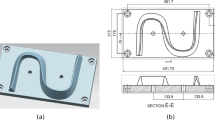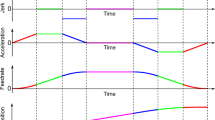Abstract
In conventional five-axis CNC machining, the machine structure is treated as a single kinematic chain just like a robotic manipulator while the cutter is treated as an end effector. In this paper, besides the machine kinematic chain, a cutter kinematic chain is introduced, and the two subkinematic chains are combined to form one machine–cutter kinematic chain. Forward, inverse kinematics and constrained inverse kinematics for the proposed machine–cutter kinematic chain are further put forward. Two applications are presented to demonstrate the advantages and effectiveness of the proposed kinematic model. The proposed kinematic model unifies the structure of the machine and cutter; therefore, the flexibility of the five-axis machine tool can be fully explored.
Similar content being viewed by others
References
Fan JH, Balla A (2008) Quadric method for cutter orientation in five-axis sculptured surface machining. Int J Mach Tools Manuf 48:788–801
Can A, Ünüvar A (2010) A novel iso-scallop tool-path generation for efficient five-axis machining of free-form surface. Int J Adv Manuf Technol 51:1083–1098
Balic J (2001) A new NC machine tool controller for step-by-step milling. Int J Adv Manuf Technol 18:399–403
Ozgedik A, Cogun C (2006) An experimental investigation of tool wear electric discharge machining. Int J Adv Manuf Technol 27:488–500
Yoon JH, Pottmann H, Lee YS (2003) Locally optimal cutting positions for 5-axis sculptured surface machining. Comput Aided Des 35:69–81
Wang Y, Wang Z, Gindy N (2009) Collision-free maching fixture design based on parametric tool space for five-axis grinding. Int J Adv Manuf Technol 45:1–7
Lo CC (1999) Real-time generation and control of cutter path for 5-axis CNC machining. Int J Mach Tool Manuf 39:471–488
Li H, Feng HY (2004) Efficient five-axis machining of free-form surfaces with constant scallop height tool paths. Int J Prod Res 42:2403–2417
Lee YS (1997) Admissible tool orientation control of gouging avoidance for 5-axis complex surface machining. Design Comput Aided Des 29:507–520
Bohez ELJ (2002) Five-axis milling machine tool kinematic chain design and analysis. Int J Mach Tools Manuf 42:505–520
Lee RS, She CH (1997) Developing a postprocessor for three types of five-axis machine tools. Int J Adv Manuf Technol 13:658–665
She CH, Chang CC (2007) Design of a generic five-axis postprocessor based on generalized kinematics model of machine tool. Int J Mach Tools Manuf 47:537–545
She CH, Huang ZT (2008) Postprocessor development of a five-axis machine tool with nutating head and table configuration. Int J Adv Manuf Technol 38:728–740
Sørby K (2007) Inverse kinematics of five-axis machines near singular configurations. Int J Mach Tools Manuf 47:299–306
Wang N, Tang K (2007) Automatic generation of gouge-free and angular-velocity-compliant five-axis toolpath. Comput Aided Des 39:841–852
Chan TF, Dubey RV (1995) A weighted least-norm solution based scheme for avoiding joint limits for redundant joint manipulators. IEEE Trans Robot Autom 11:286–292
Li X, Dong S, Venuvinod PK (2000) Hybrid learning for tool wear monitoring. Int J Adv Manuf Technol 16:303–307
Bradley C, Wong YS (2001) Surface texture indicators of tool wear—a machine vision approach. Int J Adv Manuf Technol 17:435–443
Kerr D, Pengilley J, Garwood R (2006) Assessment and visualization of machine tool wear using computer vision. Int J Adv Manuf Technol 28:781–791
Author information
Authors and Affiliations
Corresponding author
Additional information
This work is supported by the National Natural Science Foundation of China (nos. 51075167, 61070235 and 51075139).
Appendix
Appendix
According to D–H convention, the transformation matrices of prismatic pair and revolute pairs are defined as follows:
where [a, b c] is the translation vector of a prismatic pair, and θ is the rotation angle of a revolute pair.
For a kinematic chain composed of a series of kinematic pairs, the transformation can be described by the product of the transformation matrices in the order of the corresponding kinematic pairs.
Rights and permissions
About this article
Cite this article
Xu, HY., Hu, L., Hon-yuen, T. et al. A novel kinematic model for five-axis machine tools and its CNC applications. Int J Adv Manuf Technol 67, 1297–1307 (2013). https://doi.org/10.1007/s00170-012-4566-5
Received:
Accepted:
Published:
Issue Date:
DOI: https://doi.org/10.1007/s00170-012-4566-5




